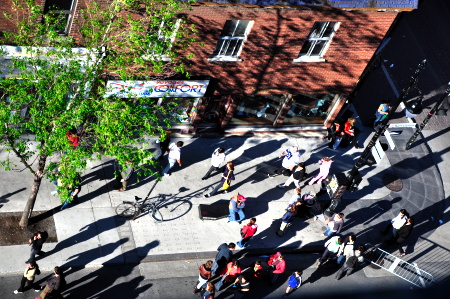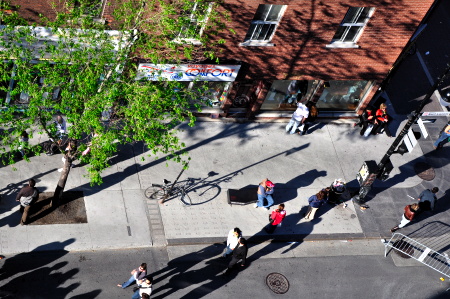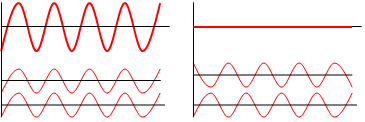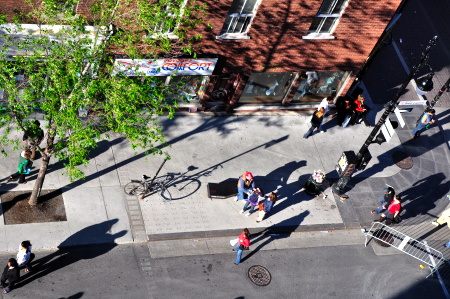
in the shadows of the urban (I)_ MTL. photo: tV
Henri Lefebvre’s last work, published posthumously, and intriguing as it is something of a skeletal meditation, is entitled Rhythmanalysis. In it Lefebvre advances two hypotheses, each unique, urgent, and radical in scope. The first, following from The Urban Revolution, is that the engine of history, so to speak, is no longer the economic base, by which Lefebvre upends the Marxian hypothesis that the means of production drive the social production of history and class. Lefebvre instead posits the urban: the urban, in itself, constitutes a breakdown between city and country, between the means of production and the superstructure. The urban is a new, epochal and thus world historical condition – a virtual set of possibilities – encompassing the ‘urban revolution’, which for Lefebvre retains its open, virtual – and thus ateleological – futurity. This thesis, nascent in Lefebvre’s work of the early ’60s (and with the SI), comes into its own in Rhythmanalysis, wherein a second hypothesis takes shape: that the urban can be read, can be analysed, by a kind of phenomenology of rhythm, a phenomenology or psychoanalysis of the urban condition.
Unlike the sociological interpretation of Lefebvre – in which the ‘urban’ is seen as an architectural phenomena of the city’s expanse, of the suburb, and in which Lefebvre’s work is thus dated to the level of a (now dated) sociological fact – I am intrigued by the broader philosophical purchase of Lefebvre’s thought on the urban and rhythmanalysis.
What is particular of this analysis is that it follows from Derrida’s deconstruction of phenomenology (in Speech and Phenomena), insofar as phenomenology cannot effectively bracket the sign by way of its transcendental reduction (the bracketing of the world in the attempt to encounter the consciousness of the phenomena present-to consciousness, aka intentionality). Derrida’s deconstruction does not discredit Husserlian phenomenology. On the contrary, it opens phenomenology to several fruitful themes, not the least the apprehension of the sign (writing-in-general), a more complex understanding of time consciousness, the substrate of technics (np. Bernard Stiegler), and what Lefebvre calls ‘rhythm’, in all of its differentiated phenomena. (In a similar vein, one can read Derrida’s deconstruction of several of the concepts of psychoanalysis — memory, repetition, time, repression, the return, the symbol — as also opening psychoanalysis to these broader themes, in a more radical sense than Freud’s application in texts such as Civilization and its Discontents).

in the shadows of the urban (II)_ MTL. photo: tV
Rhythm comes to the fore in Lefebvre (and in Derrida). Rhythm, not as a motif or metaphor for the passing of time, nor of history, class, production or place, but as its occurence in-itself. As something of the stuff of things, the warp and woof of what comes to measure and differentiate. And yet something felt: the affect of differentiated repetition, the felt passing and upcoming, structured into the complex semiotics of ritual, calendar, measured time, music and dance. Rhythm: a way in which to grasp, for Lefebvre, the urban revolution, which is the invisible and silent rhythm, the standing-wave or superposition of obverse rhythms so that their overlay becomes imperceptible (a similar hypothesis is to be found in Deleuze and Guattari’s A Thousand Plateaus (more on this later); rhythmanalysis opens an encounter, perhaps, between D&G and Derrida, for the analysis of the imperceptible suggests an aporia, which lends itself to a quasi-transcendental approach by way of a quasi-Kantian analysis of conditions of possibility).
(Note to self again: ‘revolution’ here is ambiguous, insofar as it loses its Marxian finalism, becomes a general condition, a rhythm which demands its own rhythmanalysis.)
The urban revolution constitutes the dominance of the urban, but in such a way that the urban cannot be distinguished as a rhythm unto itself, but rather as the apparent lack of rhythm onto which differentiated rhythms are perceived. The urban is not a phenomena to consciousness in this sense; it is the effect of superposition, in which their inverse relation produces phase cancellation.

Superposition on the right (phase cancellation).
As differences between the means of production and their architectures of habitation and circulation — city and country (and thus their classes, proletariat and bourgeoisie) — merge into a general condition, that of the urban condition, the analysis of rhythmic difference eclipses that of dialectical difference. (At least, this is how Lefebvre sees it; Derrida would argue that this eclipse is precisely what is at work in-general, though he too, I think, remains deeply ambivalent as to the historical status of différance, and even fundamentally so, insofar as différance must remain indecisive — this at least is how I read the meaning of ‘infinite différance is finite’ in Of Grammatology. In any case, it is this ambivalence that Stiegler exploits as he, unlike Derrida, decisively claims technics, qua the substrate, as the historical condition of the différance of différance.)
Rhythm can be analysed by way of an embodied meditation — a practice in-between phenomenology and psychoanalysis — and, according to Lefebvre, classified into three fundamental categories (arrhythmia, eurhythmia, isorhythmia), and through its analysis the specific characteristics of the urban in its architectural centripetality (the city) can be identified. This process is somewhat flawed, insofar as Lefebvre at times appears to categorize rhythm by way of a dialectic, and to claim that rhythm can identify what would be the essential characteristic — rhythm — of a particular urban locale (city). That rhythm could essentialize a locale, or determine its essential identity, would mean that it entails a dialectical finalism in itself — a hypothesis that strains against Lefebvre’s more radical assertion of the polyrhythmic, and not strictly dialectical, operations of the urban, and of the complexities inherent in the aporia of the urban as the rhythm invisible (obverse superposition: a standing-wave). In this respect too Lefebvre overemphasizes the significance of the city as the site of rhythm, as the privileged place of urban identity. But these are fruitful aporia, by way of a deconstruction, of Lefebvre’s bold meditation on rhythm as an embodied practice (in a way Bataille would appreciate). This embodied practice reveals a way to read a (rhythmic) shift in the technics of world historical conditions (the urban revolution). As any dancer or musician knows (as any body knows), rhythm is felt.
The particular rhythms of a place are observable by way of embodied perception, in the oscillation between stasis (the poses of still meditation, listening, focus) and movement (the dance, the flâneur, the dérive). Radical political practice has taken up the oscillation of rhythm. But this is not the only aspect of rhythmanalysis. Rhythmanalysis affords an opening between différance and embodied experiences of stasis/movement. It generates the context for theoretical dialogue, not the least to continue deconstruction by other means, by way of embodied practice.
Rhythmanalysis, here motivated as an opening to Afrofuturism, to rhythm as practice in which not only the (apparent) dialectic between city/country disintegrates to the general rhythm of the urban, but that between philosophy and practice itself.

in the shadows of the urban (III)_ MTL. photo: tV
Tags: D&G, Derrida, Lefebvre, rhythmanalysis
.tinyUrl for this post: | https://tinyurl.com/y55r4d3g .




 RT
RT 
OK, i’m hooked. And effectively see why the ‘closed gardens’ of fb superimposed badly with the interconnected flow of these pieces. You probably already have this work “Rhythms: On the Work, Translation, and Psychoanalysis” by Nicolas Abraham. It is inordinately rich and seems in the same ballpark as the above. Look forward to dialoging about rhythm with you from various perspectives. 😉
Thanks for reminding me about Abraham. I spent some time with Abraham & Torok on the crypt, via Derrida’s introduction “Fors,” and also because of a little known but brilliant work, Cryptomimesis by Jodey Castricano. Castricano was a student of Lorraine Weir’s.
Other than Abraham’s phenomenological rhythmatics the other thing that comes to mind is Bahktin’s analysis of the agora as chronotope. It seems you see a rhythmicized chronotope in the unconscious space of the urban, that is, in the cold alien desert world that is the teeming world, the chronotope itself.
Heh, it’s funny to read your references, for it brings me back to the world of English Lit (Bakhtin, and so on). Lots there, but I tend to head off in other directions these days; tangents between chaos physics, political theory and philosophy.
The thing about the urban as new manifest of the polis is that it’s a material substrate whose organising differences are in superposition. Chronotope? Unconscious? Not clear to me. But certainly links to be made.
Lefebvre, ciudad y ritmoanálisis. The city be the rhythm invisible: http://t.co/7Q935OW